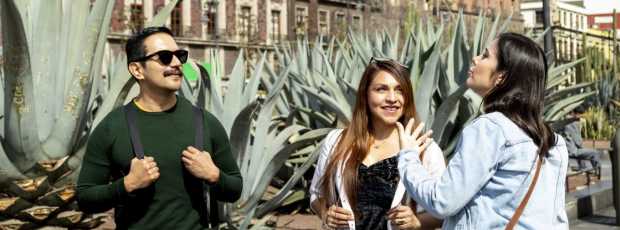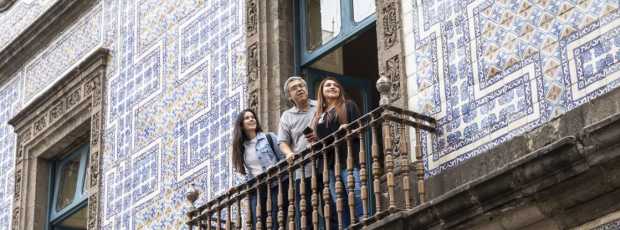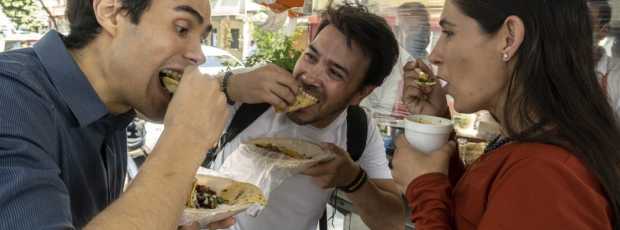See Mexico City’s hidden side on a private tour
Private tours, designed around you
Table Of Contents
- What November Weather Feels Like Here
- Day of the Dead: What Happens Here
- The Historic Center and Cultural Sites That Matter in November
- What November Looks Like Day to Day
- Beyond Day of the Dead: Día de la Revolución and the Start of the Holiday Season
- Practical Tips for Visiting Mexico City in November
- Frequently Asked Questions About Mexico City in November
- Why November Changes How You See This City

Marigold petals scattered on Coyoacán cobblestones at dusk
Tells stories through salsa, sobremesa, and street corner
This is when the city shows you who she really is. The rainy season wraps up, the weather sits at that sweet spot where you can walk all day without melting, and the entire city participates in Day of the Dead. Not performs it for tourists, participates in it. That difference matters. If you're looking for authentic Mexico City experiences, November delivers them without filter.
The temperatures run about 79°F (26°C) during the day and drop to 57°F (14°C) at night. You'll want a light jacket for evenings, but days are comfortable enough that you can spend hours wandering without thinking about the weather. And unlike summer months when afternoon storms can trap you inside, or winter months when evenings get properly cold, November just works.

Clear morning view of Popocatépetl volcano from Paseo de la Reforma
What November Weather Feels Like Here
People ask me about the rainy season, worried they'll spend their trip dodging storms. By November, that's done. We get maybe one or two light showers the entire month, usually at night. What you get instead are these clear, bright mornings where the air feels clean and the light hits the buildings just right.
My abuela says November is when the city breathes again after the summer rains. She's not wrong. The streets dry out, the parks fill up with families, and everyone seems to spend more time outside. This is when I take visitors to places like Paseo de la Reforma in the early morning. You can see the volcanoes in the distance on clear days, something that's rare here. The comfortable weather opens up all sorts of things to do in Mexico City that feel less manageable during hotter months.
The temperature difference between day and night means layering is your friend. I usually start with a t-shirt, carry a sweater in my bag, and by 8 PM I'm wearing it. If you're planning to stay out for the Day of the Dead celebrations that run late into the night, bring something warmer. The festive atmosphere more than makes up for the chill, but you don't want to cut your night short because you're cold.
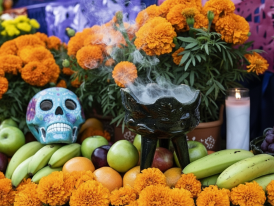
Copal incense smoke rising from the altar with marigold petals
Day of the Dead: What Happens Here
Forget what you've seen in movies. Día de los Muertos in Mexico City is both more intimate and more communal than that. Yes, there's a massive parade now (a relatively new tradition that started after that James Bond film shot here), but the real celebration happens in neighborhoods, at kitchen tables, in markets, and at cemetery gates.
Día de los Muertos in Mexico City isn't one celebration, it's hundreds happening simultaneously across neighborhoods, each with its own character. What you experience depends on where you go and when. Here's what to expect in different parts of the city.
How Coyoacán Celebrates
In Coyoacán, where I live, the preparations start in late October. Local markets fill with supplies for altars: marigolds (cempasúchil), copal incense, sugar skulls, and papel picado. My grandmother and I spent an afternoon setting up our family altar with photos of my grandfather, his favorite mezcal, the cigarettes he liked, and platters of mole that my abuela makes from his mother's recipe.
The Plaza de la Constitución downtown transforms into something else entirely. Massive public altars, each one dedicated to different communities or causes. Dance performances that go on for hours. Street vendors sell everything from traditional Mexican treats to crafts. The parade features elaborate floats that wind through the historic center, and yes, it's spectacular, but don't miss the smaller, quieter moments happening in the neighborhoods.
The Food You Can't Skip
Pan de muerto appears everywhere in November. Not just in bakeries. Street vendors sell it warm, dusted with sugar, and it's one of those things where you think you'll try it once and then you're buying it every day. The bread is soft, slightly sweet, with that orange blossom flavor that immediately smells like November to me.
But Day of the Dead food goes deeper than that. Families make the favorite dishes of their deceased relatives. In my neighborhood, I smell mole, pozole, and tamales cooking all through early November. Traditional Mexican restaurants offer special menus, and honestly, this is when you eat some of the best authentic Mexican cuisine in the city because everyone's cooking with intention.
Understanding What You're Witnessing: How Ancient and Catholic Traditions Became One
This celebration shows you the blend of indigenous and Catholic traditions that defines Mexican culture. The marigolds and copal come from our indigenous past. The Aztecs used them in death rituals. The prayers and the November 1st and 2nd timing come from the Catholic calendar of All Saints' Day and All Souls' Day. What you see now is this rich and diverse tradition that's uniquely ours.
The parade features elaborate floats, face paint, costumes, and a festive and theatrical atmosphere that's relatively new but has become part of how Mexico City does Day of the Dead now. The souls day celebrations in cemeteries are older. Families spend the night at graves, bringing food and music and stories. Both the spectacle and the intimacy coexist.
What makes it a lively and colorful event isn't the decorations, though those are everywhere. It's the spirit. We're not mourning, we're remembering. We're not sad, we're celebrating that these people existed and mattered and are still part of our lives. That's what visitors often don't expect, how joyful it all feels.
Looking for a private city experience in Mexico City?
Explore the city with a local who plans a private day just for you; no groups, no scripts.

Morning light on Teotihuacan Pyramid of the Sun
The Historic Center and Cultural Sites That Matter in November
The historic center gets packed during Day of the Dead, but that's when it shows you what it's really for. Not preservation, but use. These aren't museum pieces, they're places where the city's history and present-day life overlap.
Buildings That Tell Stories: From the Zócalo to Bellas Artes
The Metropolitan Cathedral sits on the north side of the Zócalo, and honestly, go inside even if churches aren't your thing. The building took almost 250 years to complete, which means you're looking at architectural layers stacked like geological time. During November, they hold special masses for Day of the Dead, and the religious events feel more meaningful during this time. You're watching something people believe in, not a performance.
The Palacio de Bellas Artes is that white marble building everyone photographs. The murals inside by Diego Rivera and other Mexican masters matter more than the exterior. They show you the political and social history that shaped this country, and November often brings special exhibitions on contemporary Mexican culture. Go early morning before tour groups clog the halls.
The Museo Nacional de Antropología, or national museum, is essential if you want to understand Mexico. The collection on Mexico's indigenous peoples and their influence on what Mexico is today will take you half a day minimum. The Aztec calendar stone alone rewrites how you think about pre-Hispanic civilization. My abuela brought me here as a kid, and I still find new things every time I visit. While everyone flocks to the main exhibits, some of the hidden gems in Mexico City are the smaller galleries dedicated to regional cultures that most visitors rush past.
Day Trips Worth Taking: Pyramids and Mountain Towns
Teotihuacan sits an hour north with some of the most impressive ancient pyramids in the world. The Pyramid of the Sun and Pyramid of the Moon dominate this ancient city that's older than the Aztecs by centuries. November weather makes the climb manageable instead of miserable like it gets in summer months.
The hot air balloon ride at sunrise costs too much and feels touristy, but floating over those impressive ancient pyramids as the sun comes up is legitimately spectacular. Book ahead for November because everyone wants clear skies.
Tepoztlán, an hour and a half south in the mountains, has its own pyramid on a cliff and a Sunday market where Tepoztlán's artistic community sells handmade work. Supporting local artists here means bringing home something with a story instead of mass-produced "artesanía." The hike to the pyramid is steep but manageable, and the views over the stunning Mexican countryside make your legs forgive you. It's designated a magical town, and unlike some that got the title for tourism reasons, this one earned it. Tepoztlán is a great example of the beauty of central Mexico, a place rich in tradition, nature, and culture. The charming and picturesque town center fills with visitors on weekends, but it never feels overrun.
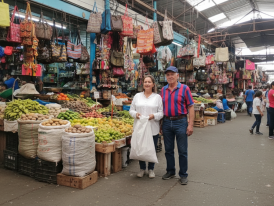
Mercado de la Merced is overflowing with fresh produce and flowers
What November Looks Like Day to Day
Local markets show you real Mexico City better than any cultural site. Mercado de la Merced overwhelms you in the best way. Produce stalls, flower vendors, fresh tortilla smell, and food counters where locals eat standing up. My abuela shops here, and watching her negotiate prices and catch up with vendors she's known for decades is like watching someone navigate their own living room. These outdoor markets are daily life, not the sanitized version.
Street vendors multiply during November, selling Day of the Dead supplies alongside regular goods. The crafts scene peaks now with papel picado, clay skulls, and traditional textiles that didn't come from a factory. You'll also find street vendors with elotes, churros, and, in the evenings, tamales. Local food from vendors is safe if you eat where locals eat. That's the only rule that matters.

Día de la Revolución parade with historic revolutionary costumes
Beyond Day of the Dead: Día de la Revolución and the Start of the Holiday Season
Día de la Revolución happens on November 20th, commemorating the start of the Mexican Revolution. You'll see parades and official ceremonies, though it's smaller than Day of the Dead. This is another window into Mexican culture and how we mark our history.
The city celebrates other holidays throughout the year. Cinco de Mayo in May (which is bigger in the US than here), Día de la Independencia (Mexican Independence Day) on September 16th, Día de los Reyes (King's Day) in January, and Semana Santa (Holy Week) in spring. But none have the cultural significance or the festive and lively atmosphere of Day of the Dead. Día de la Raza on October 12th marks Columbus's arrival, though the cultural celebration has evolved to honor indigenous heritage more than colonization.
By late November, the holiday season starts creeping in. You'll see decorations going up, though the big holiday crowds don't arrive until December. November avoids both the spring break masses and the holiday crowds while giving you pleasant weather and cultural events.
What if your day in Mexico City was planned by someone who knows it — and you?
City Unscripted matches you with a local host who creates a private experience based on your interests, not a set route.

Tree-lined walking street in Condesa with boutique shops
Practical Tips for Visiting Mexico City in November
I get asked practical questions constantly. How to get around, where to stay, whether it's safe. Here's what matters based on living here, not reading about it.
Getting Around the City
- Metro and Metrobús: Lines 1, 2, and 3 hit the major cultural sites. During Day of the Dead, stations near the Zócalo pack tight, so add extra time.
- Uber and Didi: Use them when you're tired or it's late. Safer than random street taxis.
- Official taxis: Sitio taxis (from taxi stands) are fine. Avoid hailing random cabs on the street.
- Walking: Roma, Condesa, and Coyoacán were designed for it. Wear shoes that can handle cobblestones or your feet will hate you by day two.
Where to Stay for Day of the Dead
- Historic center or Coyoacán: Walking distance from the Zócalo and major Day of the Dead celebrations. Coyoacán gives you a neighborhood feel with less chaos.
- Roma and Condesa: Better food and nightlife with live music venues. They do Day of the Dead on a smaller neighborhood scale.
- Book early: November fills up fast because of the celebrations. Good places go first.
Eating Well Without Tourist Traps
- Walk away from major sites: Restaurants near tourist landmarks are expensive and mediocre. Walk three blocks in any direction for better food at half the price.
- Comedores: Small family-run places with daily menus. My favorite is in Coyoacán, run by two sisters cooking their mother's recipes for 30 years.
- Ask locals: Where they eat is where you want to eat.
- Markets: Mercado Roma for modern takes, Mercado de San Juan for ingredients and prepared foods you've never seen.
- Bring cash: Cards don't work everywhere, especially at smaller vendors and markets.
Safety Reality Check
- Day of the Dead security: Police presence is heavy everywhere tourists go during the celebrations.
- Basic rules: Valuables hidden, awareness up, and empty streets at night are avoided.
- Safe neighborhoods: Roma, Condesa, and Mexico City's historic center are fine for tourists.
- Solo travelers: Stick to lit, busy areas after dark.
- Families: The city welcomes kids. Day of the Dead is a family event where children participate, not just watch.
What to Pack for November Weather
- Layers: T-shirt for the day, sweater for the night. Temperature swings from 79°F (26°C) during the day to 57°F (14°C) at night.
- Walking shoes: Not fashion shoes. You'll cover miles on cobblestones.
- Light rain jacket: For insurance, though you probably won't need it.
- Sunscreen and hat: Essential for day trips to places like Teotihuacan.
- Dress respectfully: For Day of the Dead, casual but respectful. This is a cultural celebration, not Halloween. Skip the costume unless you're in an organized event.
Frequently Asked Questions About Mexico City in November
- Is November a good time to visit Mexico City?\ November offers ideal weather, with mild temperatures that make it a great time to explore. It’s not as hot as summer or as cold as winter, and you get to experience Day of the Dead, one of the city’s most important cultural events. The tourist crowds are also thinner compared to other months.
- What festival takes place in Mexico City in November?\ Día de los Muertos (Day of the Dead) is the main celebration, observed on November 1st and 2nd. This festival honors deceased loved ones with altars, parades, and food. The Día de la Revolución on November 20th is also a key event, though smaller than the Day of the Dead celebrations.
- What should I wear in Mexico City in November?\ Bring layers. The days are typically warm, with temperatures around 79°F (26°C), but the nights cool down to 57°F (14°C). A light jacket or sweater is needed for the evenings. Comfortable shoes are important for all the walking you'll do exploring the city’s sights.
- Is November hurricane season in Mexico?\ While hurricane season runs through November, Mexico City is inland, far from the coast. Hurricanes don’t reach the city, so the weather remains stable. The rainy season ends by October, and November usually brings clear skies.
- What to do in Mexico City's historic center during November?\ You can visit the Day of the Dead altars in Plaza de la Constitución, the Metropolitan Cathedral, and the Palacio de Bellas Artes. The area is vibrant with dance performances, street food, and cultural events. It’s also quieter in the early morning, perfect for exploring.
- What cultural events happen in Mexico City in November?\ Besides Day of the Dead, museums host special exhibitions. Día de la Revolución on November 20th brings parades. Many cultural sites offer extended hours and special programs. It's a great month to catch multiple events celebrating Mexico’s culture.
- What's the best day trip from Mexico City in November?\ A trip to Teotihuacan is ideal. The Pyramids of the Sun and Moon are stunning, and November’s cooler temperatures make the climb enjoyable. If you're looking for a more relaxing trip, consider Tepoztlán, a picturesque town with an artistic vibe and great hiking.
- How do locals celebrate Día de los Muertos?\ Families create altars at home with photos, food, and flowers to honor the deceased. Many visit cemeteries to clean graves, bringing offerings like pan de muerto. Some take part in public parades, while others prefer more intimate family gatherings.
- What are the best areas to stay in Mexico City for Día de los Muertos?\ Stay in Coyoacán for a quieter, neighborhood experience. For easy access to large celebrations, the historic center is ideal. If you prefer vibrant nightlife and food, Roma and Condesa are great options.
- What are the must-try foods in Mexico City during November?\ Pan de muerto is a must during Day of the Dead. You’ll also find mole, pozole, and tamales served in markets and homes. Local restaurants offer special menus, serving authentic Mexican dishes made with love and tradition.

November sunset over Mexico City with altar candles in foreground
Why November Changes How You See This City
I've lived in Mexico City my entire life, and November still gets me. Maybe it's the light after the rain stops, or how the whole city smells like copal and marigolds, or watching my abuela tell stories about my grandfather while arranging his altar. This month has weight.
When you visit Mexico City in November, you're not seeing the tourist version. You're seeing us as we are, honoring our dead and celebrating culture, and just existing. The Day of the Dead celebrations aren't performed for visitors. You're witnessing something real.
This is the Mexico City I want you to see. Not monuments as backdrops or neighborhoods as photo sets, but the living city where diverse traditions going back centuries blend with ones we're still creating. Where death transitions rather than ends, and November welcomes everyone home.
Tip
We match you with the right host, not just any guide.Want to experience the real Mexico City with someone who lives there?
A fully private experience, planned and led by a local host who tailors the day to you
Ready to plan your perfect day in Mexico City?
Start your experienceWhat if your day in Mexico City was planned by someone who knows it — and you?
City Unscripted matches you with a local host who creates a private experience based on your interests, not a set route.
Want to experience the real Mexico City with someone who lives there?
A fully private experience, planned and led by a local host who tailors the day to you

